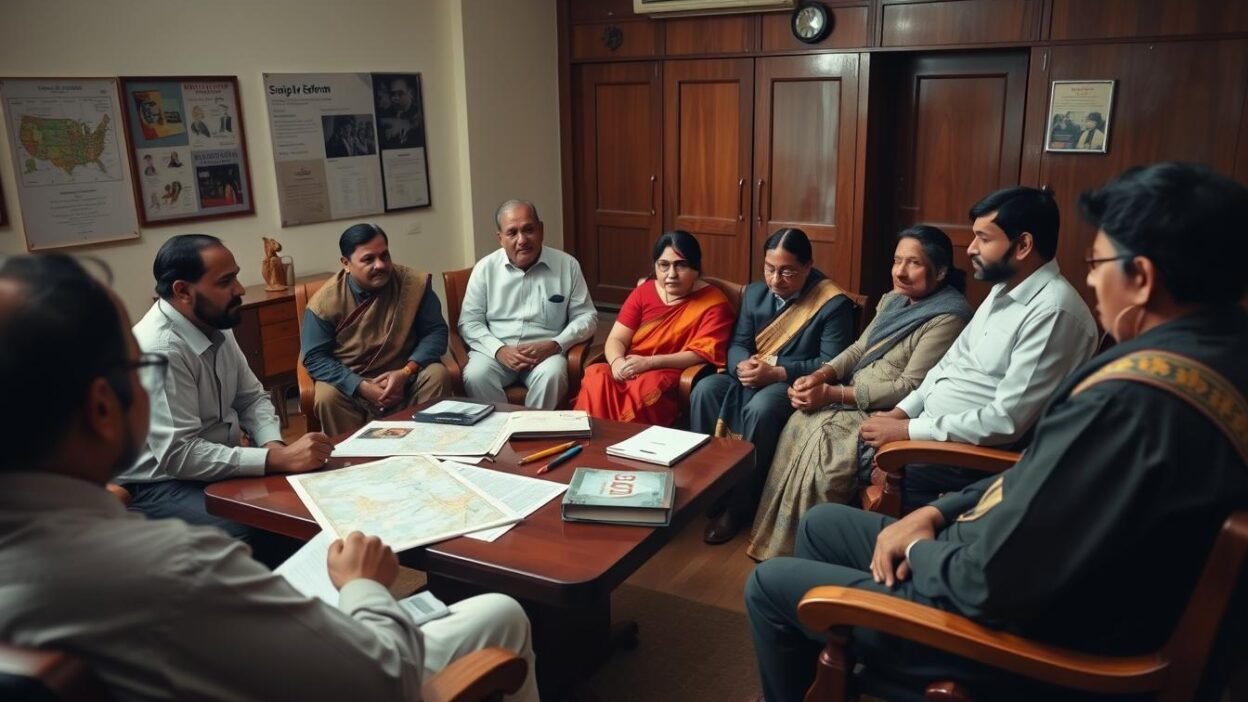In 1964, 70% of India’s population couldn’t read or write. This alarming situation called for urgent educational reform. The Kothari Commission was formed to tackle this challenge head-on.
Dr. D.S. Kothari led this groundbreaking initiative. The commission’s goal was to overhaul India’s education system completely. They aimed to create a modern, inclusive, and effective learning environment for all.
Preparing for the UGC NET exam can be a daunting task, but with the right resources, candidates can navigate the process effectively. Websites like MyJRF provide a comprehensive platform for aspiring educators, offering specialized guidance for UGC NET Paper 2 preparation and essential tips for acing UGC NET Paper 1. Additionally, understanding the revised syllabus provided by UGC is crucial for a targeted study approach. For official announcements and updates, candidates should regularly visit the UGC NET NTA portal, while the UGC’s job section and the main UGC website are invaluable for post-exam opportunities and academic resources. With these tools, candidates can maximize their preparation and set themselves up for success.
The commission included top educators, policymakers, and visionaries. For two years, they analyzed and recommended changes to India’s education system. Their work focused on improving both school and higher education.
Key Takeaways
- The Kothari Commission was established in 1964 to address India’s education crisis
- It aimed to reshape India’s educational landscape through comprehensive reforms
- Dr. D.S. Kothari led the commission, which included prominent educators and policymakers
- The commission’s work spanned two years, focusing on both school and higher education
- Its recommendations laid the groundwork for modern Indian education policies
Introduction to the Kothari Commission
India formed the Kothari Commission in 1964 to reshape its educational policy. Led by Dr. D.S. Kothari, the commission aimed to reform the nation’s education system. It examined every aspect and proposed comprehensive changes.
The commission brought together top minds in education. Its members included respected educators, policymakers, and experts from various fields. This diverse group crafted a vision for India’s educational future.
“Education is the most powerful weapon which you can use to change the world.” – Nelson Mandela
The commission’s work set the stage for major educational changes in India. It examined all levels of schooling, from primary to university. The team also explored how education could support India’s growing economy and society.
| Focus Areas | Key Objectives |
|---|---|
| School Education | Improve quality and access |
| Higher Education | Enhance research and autonomy |
| Vocational Training | Align with industry needs |
| Teacher Education | Strengthen training programs |
The Kothari Commission’s work marked a pivotal moment in India’s educational journey. Its recommendations shaped policies for years to come. The commission guided India’s path towards knowledge and progress.
Objectives of the Kothari Commission
The Kothari Commission aimed to reshape India’s education system. It sought to create a modern and fair learning framework. The commission focused on improving education quality and aligning it with national development goals.
Understanding the Commission’s Vision
The Kothari Commission imagined a new educational landscape for India. It wanted a system that met the needs of a growing nation.
The commission’s vision stressed equal access to education for all. It also focused on better teaching and learning methods. Including science and technology in courses was another key point.
- Equal access to education for all citizens
- Improvement in the quality of teaching and learning
- Integration of science and technology in curricula
- Promotion of national unity and cultural values
Key Goals for Educational Improvement
The commission set specific goals to improve Indian education. These goals covered all levels, from primary school to higher learning.
| Goal | Description |
|---|---|
| Universal Education | Provide free and compulsory education up to age 14 |
| Teacher Training | Enhance the quality and standards of teacher education |
| Research Focus | Boost research activities in universities and colleges |
| Vocational Education | Introduce vocational streams in secondary education |
These objectives shaped major reforms in Indian education. They guided policy-making and educational practices for many years. The commission’s work left a lasting impact on the country’s learning system.
Historical Context of Education in India
India’s educational landscape has evolved significantly since ancient times. The Gurukul system, where students lived with teachers, formed the basis of India’s educational heritage. This approach focused on holistic learning and character development.
British colonizers introduced Western-style education, emphasizing English language and literature. This change brought new opportunities but created a divide between English-educated elites and the masses.
After independence, India faced challenges in reforming its educational policy. The government set up committees to address issues in the education sector. These efforts aimed to boost literacy rates and expand access to education.
The Indian education system grappled with inadequate infrastructure and teacher shortages. These challenges highlighted the need for comprehensive reforms. This set the stage for the Kothari Commission’s groundbreaking work.
“Education is the most powerful weapon which you can use to change the world.” – Nelson Mandela
India’s educational journey reveals a complex path of development. It shows the importance of adaptive policies for a diverse nation. These policies should address unique needs while promoting innovation in education.
Key Recommendations of the Kothari Commission
The Kothari Commission proposed vital academic changes for India’s education system. These ideas aimed to improve learning quality across the nation. They sought to transform educational institutions throughout the country.
National Policy on Education
The Commission called for a comprehensive National Policy on Education. This policy aimed to standardize educational practices across India. It stressed equal access to quality education for all citizens.
Curriculum Reforms and Innovations
The Commission focused on reshaping the curriculum. They suggested a more flexible approach to meet different learning needs.
- Introducing vocational subjects alongside academic ones
- Promoting regional languages in education
- Emphasizing science and mathematics education
- Incorporating environmental studies into the curriculum
Enhancing Teacher Training Programs
The Commission highlighted teachers’ vital role in education reforms. They proposed improving teacher training to boost instruction quality. Their suggestions aimed to create better educators.
| Recommendation | Expected Outcome |
|---|---|
| Establishing specialized teacher training institutes | Improved pedagogical skills |
| Providing continuous professional development | Up-to-date teaching methods |
| Enhancing teacher salaries and benefits | Attracting and retaining quality educators |
| Introducing technology in teacher education | Modern, tech-savvy instructors |
These ideas shaped India’s education system for decades. They influenced policies and practices throughout the country. The Commission’s work laid the groundwork for significant educational changes.
The Role of Central and State Governments
The Kothari Commission advocated for a balanced approach in Indian education. It stressed cooperation between central and state governments for effective educational reforms. The commission proposed a framework dividing responsibilities between central and state governments.
The central government’s role included setting broad educational policies. It also focused on allocating resources for education. Additionally, it was responsible for setting standards for curriculum and teaching.
State governments were tasked with implementing educational policies. They managed schools and colleges. States also adapted curriculum to local needs.
This division aimed to create a unified yet flexible educational policy. It allowed for national cohesion while respecting regional diversity across India.
| Government Level | Primary Responsibilities |
|---|---|
| Central | Policy formulation, resource allocation, standard-setting |
| State | Policy implementation, institution management, local adaptation |
The commission’s recommendations shaped collaborative education in India. This framework still influences educational governance today. It guides policy creation and implementation across the nation.
Impact on School Education in India
The Kothari Commission’s ideas led to big changes in Indian education. These changes improved schools and made learning better for all students.
Changes in School Infrastructure
Indian schools got better buildings and tools. New classrooms, libraries, and labs were built to help students learn more.
Rural schools saw big improvements too. The focus was on making schools modern and well-equipped.
Science labs were added to high schools. This helped students learn by doing experiments. The table shows how school facilities grew after the commission’s ideas:
| Facility | Pre-Commission | Post-Commission |
|---|---|---|
| Classrooms | 500,000 | 750,000 |
| Libraries | 20,000 | 35,000 |
| Science Labs | 5,000 | 15,000 |
Inclusive Education Initiatives
Schools started helping all types of students learn together. This included kids with different needs and abilities.
Special teachers were trained to help students with disabilities. This made sure all kids could get a good education.
Schools began teaching in many languages. This helped kids learn better in their own language. These new ideas are now used in schools across India.
Higher Education Transformation
The Kothari Commission’s academic recommendations revolutionized India’s educational institutions. It aimed to align universities with national development goals. The vision granted universities greater autonomy.
Autonomy of Universities
The commission advocated for increased freedom in university operations. This meant less government control and more power for educational institutions. Universities gained authority to shape curricula, manage resources, and make key decisions.
This approach aimed to foster innovation and adaptability in higher education. It empowered institutions to respond to changing needs effectively.
Research and Development Focus
A major push for educational development came through emphasizing research. The commission made several key recommendations.
- Increasing funding for research projects
- Creating dedicated research centers within universities
- Encouraging collaboration between academia and industry
These steps aimed to boost India’s scientific and technological capabilities. Universities were seen as key drivers of national progress. They would achieve this through cutting-edge research and innovation.
“Universities must be centers of excellence, pushing the boundaries of knowledge and contributing to societal advancement.”
The Kothari Commission reimagined the role of higher education in India. It laid the groundwork for transforming the academic landscape. Its recommendations continue to shape educational policies and practices today.
Vocational Education and Skill Development
The Kothari Commission saw vocational education as crucial for India’s future workforce. It aimed to blend academics with practical job skills. This approach sought to create a diverse, adaptable workforce through education reforms.
The commission proposed integrating vocational training into mainstream education. This policy shift aimed to combine practical skills with theoretical knowledge. It addressed the growing need for skilled workers in various industries.
Key recommendations included:
- Establishing specialized vocational institutions
- Introducing vocational subjects in secondary schools
- Creating stronger links between educational institutions and industry
These initiatives aligned educational outcomes with industry needs. The commission’s foresight laid the groundwork for significant education reforms. It addressed India’s future workforce requirements effectively.
“Vocational education is not just about job training; it’s about empowering individuals to contribute meaningfully to society and the economy.”
The focus on skill development aimed to reduce unemployment among graduates. It equipped students with practical skills to boost employability. This approach continues to shape India’s educational policy today.
The goal is to harness India’s demographic dividend through vocational education. It empowers individuals to contribute meaningfully to society and the economy.
Challenges in Implementation
The Kothari Commission’s vision for India’s education faced major hurdles. The system struggled to put the commission’s ideas into practice. Implementation proved difficult despite ambitious goals.
Administrative Hurdles
Bureaucratic red tape slowed progress in many states. Schools lacked trained staff for new curricula. Poor communication between central and state bodies hindered coordinated efforts.
Financial Constraints
Limited budgets restricted educational reforms. Many schools couldn’t afford new teaching aids or better infrastructure. Teacher training programs suffered from lack of funds.
| Challenge | Impact |
|---|---|
| Lack of funds | Outdated facilities, limited resources |
| Bureaucratic delays | Slow policy implementation |
| Untrained staff | Poor quality of education |
| Communication gaps | Uneven reform across states |
The Kothari Commission laid crucial groundwork for future improvements. Its ideas continue to shape educational policies today. These recommendations inspire ongoing efforts for reform in India’s education system.
The Legacy of the Kothari Commission
The Kothari Commission’s impact on India’s education is profound. Its recommendations shaped reforms for decades. The commission’s vision guides modern, inclusive education systems.
- Emphasis on science and technology education
- Focus on teacher training and quality
- Promotion of vocational education
- Stress on moral and social values in curriculum
The 1986 National Policy on Education drew from Kothari Commission recommendations. This policy led to major educational reforms in India.
| Kothari Commission Recommendation | Impact on Education Policy |
|---|---|
| Common school system | Sarva Shiksha Abhiyan launched in 2001 |
| Three-language formula | Implemented in many states |
| University autonomy | Graded autonomy scheme introduced in 2018 |
The commission’s focus on lifelong learning echoes in current initiatives. Its vision of education as a development tool inspires policymakers.
“Education is the most powerful weapon which you can use to change the world.” – Nelson Mandela
India faces new educational challenges today. The Kothari Commission’s principles of equity and quality remain relevant.
Its legacy continues to shape India’s educational journey. These ideas guide future reforms in the country.
Current Relevance of the Commission’s Recommendations
The Kothari Commission’s vision still shapes India’s education. Its principles guide modern academic reforms. The commission’s foresight set the stage for crucial innovations in today’s learning environment.
These ideas drive educational development in India. They ensure quality education remains accessible to all. The commission’s legacy continues to evolve, meeting new challenges head-on.
Integration into NPE 2020
The National Education Policy 2020 builds on Kothari Commission’s ideas. It focuses on holistic learning and skill development. The policy also promotes research-oriented education, aligning with the commission’s original vision.
These core concepts adapt to 21st-century challenges. They address the needs of India’s current education system. The policy aims to prepare students for a rapidly changing world.
Innovations in the Digital Era
The digital age brings new life to the commission’s focus on practical learning. Online platforms now complement traditional teaching methods. Educational technologies make learning more accessible and engaging for students.
This blend of old wisdom and new tools is powerful. It drives educational progress across India. Students now have more opportunities to learn in diverse ways.
FAQ
What was the Kothari Commission?
The Kothari Commission was a major education reform initiative in 1964. It examined all aspects of Indian education. The commission, led by Dr. D.S. Kothari, proposed wide-ranging recommendations to reshape India’s academic landscape.
What were the main objectives of the Kothari Commission?
The Commission aimed to improve access to education and enhance teaching standards. It focused on aligning education with national development goals. The Commission also sought to create a modern, fair, and quality-driven education system in India.
How did the Kothari Commission impact school education in India?
The Commission’s recommendations led to significant changes in school infrastructure and curriculum. It also improved teaching methods. The Commission emphasized inclusive education to address diverse student needs across India.
What changes did the Kothari Commission propose for higher education?
The Commission recommended giving more freedom to universities and improving research capabilities. It proposed reforms in college and university structures and curricula. The Commission also aimed to align higher education with national development goals.
How did the Kothari Commission address vocational education?
The Commission stressed integrating vocational training into mainstream education. It proposed creating specialized vocational institutions. The Commission also focused on aligning educational outcomes with industry needs.
What challenges were faced in implementing the Kothari Commission’s recommendations?
Implementation faced administrative hurdles, financial constraints, and resistance to change. These issues highlighted the difficulties of educational reform in India. The complexities showed the challenges of improving education in a diverse, developing nation.
How relevant are the Kothari Commission’s recommendations today?
Many of the Commission’s core principles still influence educational policies today. Its ideas have shaped the National Education Policy 2020. The recommendations continue to guide India’s educational philosophy, adapting to modern challenges like digital learning.
What was the role of central and state governments in implementing the Commission’s recommendations?
The Commission suggested a balance between centralized policy-making and decentralized execution. It stressed the importance of cooperation between different government levels. This approach was crucial for effectively implementing educational reforms.
How did the Kothari Commission influence India’s National Policy on Education?
The Commission’s recommendations formed the basis for India’s first National Policy on Education in 1968. This policy set the framework for future educational developments. It guided subsequent reforms in the country’s education system.
What was the historical context that led to the formation of the Kothari Commission?
The Commission formed in response to post-independence India’s need for comprehensive educational reform. It aimed to address challenges in the education system inherited from colonial times. The goal was to align education with the aspirations of a newly independent nation.





